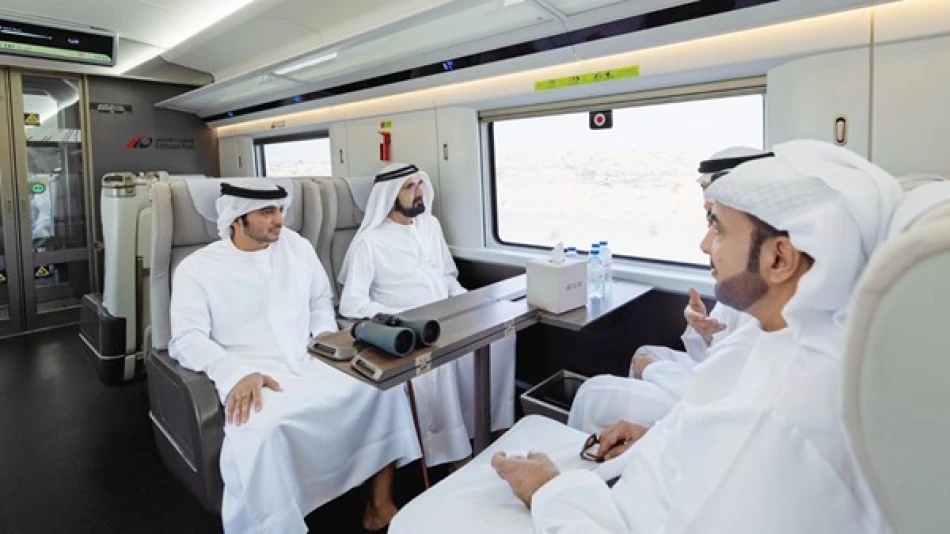
Dubai's Leader Lauds Union Train Team Led by Dheyab bin Mohamed bin Zayed
UAE's $11 Billion Railway Gamble: Can High-Speed Rail Transform the Gulf's Transport Future?
The UAE is positioning itself as the Gulf's railway pioneer as Sheikh Mohammed bin Rashid Al Maktoum took a test ride on the Etihad Rail passenger service from Dubai to Fujairah, signaling the imminent launch of the region's most ambitious transport infrastructure project. Set to begin operations next year, the 200 km/h network promises to carry 36 million passengers annually by 2030 while connecting 11 cities across the Emirates—but success will depend on overcoming the Gulf's deeply entrenched car culture.
A Regional First: High-Speed Connectivity Across the Emirates
The Etihad Rail passenger network represents a fundamental shift in Gulf transportation strategy. Unlike the freight-focused railways common across the region, this system prioritizes passenger mobility with trains capable of reaching 200 kilometers per hour. The Dubai-Fujairah route showcased during Sheikh Mohammed's journey spans approximately 115 kilometers, cutting travel time from over two hours by car to roughly 50 minutes by rail.
The network's scope extends far beyond a single route. Plans call for connecting 11 major cities and regions, from the commercial hub of Dubai to the eastern port city of Fujairah, creating the UAE's first comprehensive passenger rail backbone. This connectivity could reshape how residents and tourists move between emirates, particularly for the millions who currently rely on congested highways.
The Economics of Ambition
Massive Investment, Uncertain Returns
The Etihad Rail project represents an $11 billion investment in infrastructure that will test whether passenger rail can succeed in a region built around automobile dependency. The projected 36 million passengers by 2030 would require significant behavioral change among UAE residents, who have grown accustomed to private vehicle ownership and extensive highway networks.
For comparison, Saudi Arabia's proposed high-speed rail between Riyadh and Dammam has faced repeated delays and cost overruns, while Qatar's Doha Metro, despite initial success, serves a much smaller geographic area. The UAE's challenge lies in creating a system that can compete with the convenience and cultural preference for private transportation.
Strategic Economic Positioning
Beyond passenger transport, the railway positions the UAE as a logistics hub connecting the Arabian Gulf to global markets. The Dubai-Fujairah corridor is particularly strategic, linking the country's commercial center to its primary port on the Arabian Sea, bypassing the congested Strait of Hormuz for certain shipping routes.
Regional Context and Global Comparisons
The UAE's railway ambitions come as Gulf states increasingly compete for infrastructure leadership. Saudi Arabia's NEOM project includes plans for "The Line," a futuristic transport system, while Qatar successfully deployed metro systems for the 2022 World Cup. However, the UAE's approach focuses on practical intercity connectivity rather than experimental technology.
Globally, successful high-speed rail networks in countries like Japan, France, and China required decades of development and substantial government subsidies. The UAE's advantage lies in its compact geography and concentrated population centers, but it faces the unique challenge of changing transportation habits in a wealthy, car-centric society.
Market and Investment Implications
The railway's launch will likely impact several sectors within the UAE economy. Real estate markets along the rail corridor may experience increased demand, particularly in secondary cities like Fujairah that gain improved access to Dubai's employment centers. Tourism operators could benefit from easier movement between emirates, while the automotive sector may face long-term pressure as alternative transport options expand.
For international investors, the project signals the UAE's commitment to diversifying its economy beyond oil and establishing itself as a regional transport hub. Success could attract similar investments in Gulf infrastructure, while failure might dampen enthusiasm for large-scale public transport projects in the region.
The Test Ahead
Sheikh Mohammed's test journey represents more than a ceremonial ride—it demonstrates leadership commitment to a project that will define the UAE's transport future. The real test begins with commercial operations next year, when the system must prove it can attract sufficient ridership to justify its massive investment.
The railway's success will depend on factors beyond engineering excellence: pricing strategies, integration with existing transport networks, and the ability to offer compelling advantages over private vehicle travel. If successful, the UAE could establish a model for sustainable transport in the Gulf. If not, it may serve as a cautionary tale about the limits of infrastructure-led development in car-dependent societies.
Most Viewed News

 Layla Al Mansoori
Layla Al Mansoori






